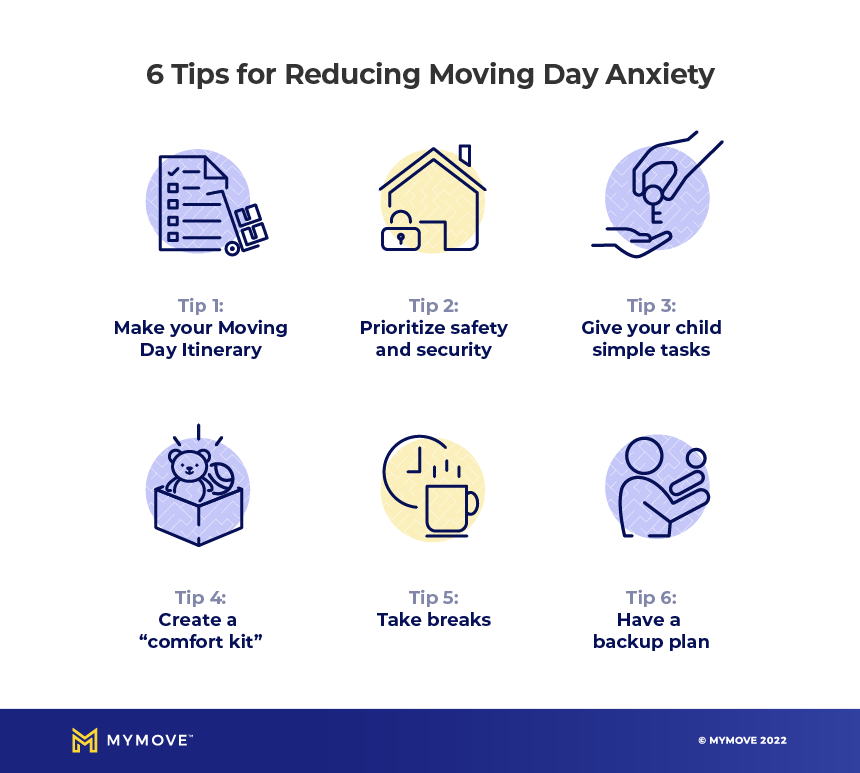Moving becomes a part of our lives at many different stages: When we move away from our parents, relocate for a job opportunity, or find somewhere new to retire. No matter your circumstances, it can be a stressful process. And if you’re moving with a child with autism, it’s especially important to help relieve moving stress for both you and your kid.
It’s easier said than done, but relocating with a child with autism — and limiting stress while doing so — is entirely possible if you prepare and plan ahead. It’s important to maintain as much of your normal routine as possible and to consider additional ways to help kids with autism while you’re moving. Maintaining normalcy will help you and your children adjust quickly to your new home so you can settle in and feel comfortable.

What is autism?
According to the advocacy site Autism Speaks, Autism Spectrum Disorder (ASD) “refers to a broad range of conditions characterized by challenges with social skills, repetitive behaviors, speech, and nonverbal communication.”
Autism Parenting magazine reports that as of 2022, approximately 1 in 44 children is identified with autism. Most children are diagnosed after the age of 4 and boys are four times more likely to be diagnosed than girls.
Autism is a spectrum disorder, meaning that there are many different subtypes, according to the Centers for Disease Control and Prevention. The way ASD manifests, and the subsequent challenges and strengths that come along with it can vary depending on the person.
So, the ways in which moving stress could impact your child may vary. This article outlines some best practices based on expert resources. But to truly prepare, you will need to consider your child’s triggers and previous experiences. We also recommend you discuss the impending move with medical professionals that you trust and who know your child.
The importance of routine in the lives of children with Autism
One of the effects of autism is difficulty processing sensory information, according to Autism Speaks, which ultimately affects behavior. Through changes in their environment, children with autism can easily experience sensory overload. Established routines are known to help prevent sensory overload by allowing children to expect predictable outcomes and relieve some of the chaos they might feel from too many changes, according to the Nebraska Autism Spectrum Disorders Network.
Maintaining as much of a routine as possible during your move will help your child feel more comfortable throughout such a big change.
How to prepare your child for an upcoming move:
When moving with a child with autism, you can prepare them using consistent communication and positive reinforcement. As their routine changes leading up to the move, you can offer rewards for completing new tasks like packing. Allowing your child to adjust to the new behaviors that come with moving will help ease stress and anxiety.
5 ways you make a move easier for your child
1. Be proactive and talk to your child about change.
Try to provide your children with as much notice as possible to prepare for the move. Even if they may not understand why you’re moving right away, you should offer as much information as you can.
Let your children know the reason why you’re moving, whether it’s for a new job, to be closer to family, or to downsize. Let them ask questions so they can gain a better understanding of their own. Experts in autism agree that adjusting to a big change will require continual communication, time, and patience.
2. Create a calendar.
Keep your child in the loop with your moving schedule. Creating a visual calendar may be the best way to keep them informed, especially since visual learning will hold their attention and help reduce anxiety. Include exact dates and times and review the schedule with them every day so they know what’s coming.
While a calendar will help provide a routine throughout the move, you’ll still be breaking away from your standard routine. Offer positive reinforcement and rewards when your children complete tasks on the calendar they haven’t done before.
3. Provide visual aids.
Visual learning will also come in handy to help your child understand why you’re moving. You can use photos of your old and new home to help them understand what’s going to change and what you need to do to prepare for the move. If you’re able to visit the new home in person, it could give you a great opportunity to help them see what’s to come. Just be sure to help them visualize what it will look like with your belongings rather than empty.
You can also use social stories or books to guide your child through the moving process. A social story might be a presentation like this example or a homemade book that explains a specific situation. As a tool for children with autism, social stories help them prepare for new experiences, so they’re less likely to feel overwhelmed.
Use this Google Presentation Template to make your own moving social story. Simply make a copy of the presentation, and replace the photos with images of your old home, your new home, and your family.
4. Allow your child to be part or own part of the packing process.
Since routine is so important for children with autism, they may have the most difficulty understanding what’s going to happen to their belongings. Keep them involved in the packing process, so they see which boxes their belongings go into and understand how their belongings are moving with the family.
Ways to make packing easier
Packing is a chore for everyone, and it can be especially tedious and confusing for your children. Try using some of the following tips to make packing easier and more fun:
- Use colorful, fun boxes that also help your children see what’s going in which box.
- Label the boxes with the contents as well as your child’s name, so they know what’s theirs.
- Pack your child’s room last so they can maintain as much normalcy as possible.
- Schedule packing up different areas of your child’s room on different days so they can prepare for each packing sprint.
- Let your child choose what they want to keep and what they might want to get rid of before the move.
- Offer a reward like their favorite meals after every successful packing day.
5. Prepare your child for other upcoming life changes.
With moving comes even more life changes that your child will have to prepare for. The change isn’t limited to a new home – they may also be attending a new school, leaving their friends, adjusting to a different climate, and more. Research shows that it’s best to stay positive while communicating with your children about changes. Emphasize the benefits of the changes, give them enough time to process what it means, and always go out your way to show how you’ll support them.

6 tips to ease your child’s anxiety on Moving Day and help your move go smoothly
Even though moving with a child with autism poses unique challenges, there are some easy tips you can follow to ease your child’s anxiety. Some of the most common ways to help kids with autism will also apply to a move, though there are ways to make sure your strategies are specific to move day.
Tip 1: Make your Moving Day itinerary.
Develop a comprehensive itinerary for your move day and share it with your child ahead of time. Within the itinerary, include as much detail as possible, such as the time everyone needs to wake up, the time that movers will be arriving (if you’re getting help), and the steps you’ll take to pack up cars and moving vehicles.
Tip 2: Prioritize safety and security.
Autism manifests in different ways for each child. Consider your child’s triggers and prioritize the ways you can help mitigate their stress. For example, your child might be significantly triggered when their belongings are packed away inside the car. They might not understand that they’ll get to see them once they’re unpacked.
Prepare with photos of their belongings and photos of your new home, so they can see where the belongings are going. Within the itinerary you’ve developed, make sure your child knows what they should be doing throughout the day, so they’re also out of the way.
Tip 3: Give your child simple tasks.
Within your itinerary, assign your child to tackle simple tasks throughout the day. Try to let them accomplish tasks they enjoy – perhaps it’s cleaning up at the end of the move or making sure everything is accounted for. Throughout the process, make sure someone is there for him or her to talk to if they have any questions or need help.
Tip 4: Create a “comfort kit.”
If the moving day is too overwhelming, it will be helpful to have a comfort kit on hand for your child. Before packing up everything, set aside some of your child’s favorite items, such as books or toys. If you see that they’re experiencing too much anxiety from the move, show them where the comfort kit is and let them know they can use it as much as they need to throughout the day.
Tip 5: Take breaks.
As part of your moving day itinerary, you should incorporate breaks where your child can rest and take time away from the move. Make sure their comfort kit is on hand during these breaks so they can play with toys that help relieve stress.
Tip 6: Have a back-up plan.
If you’re well prepared, move day can be made as stress-free as possible. However, things can always go wrong. Your child may experience more anxiety than you anticipated. If so, have alternate childcare in place so they can be somewhere away from the chaos of moving day. Consider a daycare, babysitter, family member, or friend — someone your child is already comfortable with — who could watch over your child for all or part of the day.
How to integrate your child into their new home, step by step:
Relocation with a child with autism takes time and patience, just like the efforts you used during the move. As you settle into your new home, practice all the beneficial ways to help kids with autism. Slowly ease your child into a new routine and keep as many things constant as you can.
Step 1: Allow your child to help unpack boxes in the new home.
Just like you let your children help pack up for the move, let them unpack once you arrive at your new home. Include them in the entire process and let them choose what they want to unpack first. You should also prioritize their room first so they can focus on unpacking their belongings and stay away from the chaos of the rest of the move.
If you can, try to have their furniture placed first so they’ll be able to visualize where everything should go. Ideally, keep everything as similar to your old home as possible, including the same layout, decorations, and curtains.
Step 2: Survey the surroundings for any new experiences or hazards.
After you’ve unpacked, analyze your surroundings. Is your home near a busy street? The noises could pose an issue for your child, so it’s important to communicate with them as soon as possible about where they can and can’t go outside of the home. Reach out to your neighbors as soon as possible and let them know about your child. Try to create a local support system as soon as possible for emergencies or child care assistance.
Step 3: Re-establish routine.
Relieving anxiety from autism always starts with routines. Work toward a solid routine as soon as you can, and make it as specific as possible. As you implement your routine, monitor for reactions like anger or sadness. What parts of the old home are missing and causing a reaction? You can help relieve your children’s emotions using social stories to help them understand how life in your new home can be just as easy and joyful as it was before.
Step 4: Find your community.
If you’re moving somewhere new, you may not know as many people as you used to. Prioritize finding a community as soon as you can. Your community might include neighbors, teachers, and organizations. Through a community, you can gain support for your child as well as yourself. You may find new experiences that your child can enjoy while taking time away from childcare for yourself.
Step 5: Create a private space.
The act of moving a child’s home and everything they know is hard to handle, but it’s a bit more overwhelming for a child with autism. To help your child feel at ease in their new home, make a special space just for them, a quiet retreat. This can be done with a simple child’s playhouse or tent. If you have the room, consider making a separate space outfitted with everything that comforts your child, with muted lighting and the least amount of sound exposure.
The bottom line
When you’re moving with a child with autism, it’s easy for caregivers and the children to get stressed out quickly. Make sure to create a comprehensive plan for packing, moving, and settling into your new home. Sticking with as much of a routine as possible will help your child adjust more quickly while catering to their needs. As long as you exercise patience and use a variety of ways to help kids with autism, you can expect a smooth transition into your new home.
Disclaimer: This content is not intended to be a substitute for professional medical advice, diagnosis, or treatment. Always seek the advice of your physician or other qualified health providers with any questions you may have regarding a medical condition.
Sources: The Centers for Disease Control and Prevention, The Marcus Autism Center, Autism Speaks, University of Rochester Medical Center, Autism.org, The May Institute, The Council for Exceptional Children, Nebraska Autism Spectrum Disorders Network, Autism Parenting magazine.
Guide written by Claire Bough. All content provided by MyMove.com to help support families and their children during the moving process.
Macaroni Kid Acton-Concord-Bedford-Lexington is a free weekly newsletter and website focused on fun events and information for local families.
We gather together all kinds of local family events and activities each week, and add useful information about classes, family-focused businesses, book and product reviews, recipes, crafts, school and camp guides and more. We proudly serve thousands of families in Acton, Bedford, Boxborough, Carlisle, Concord, Lexington, Lincoln, Maynard and other surrounding communities.
Subscribe today to receive our email newsletter every Thursday!
Follow us on Facebook, Instagram or Twitter.
Advertise with us to connect with thousands of local families!



